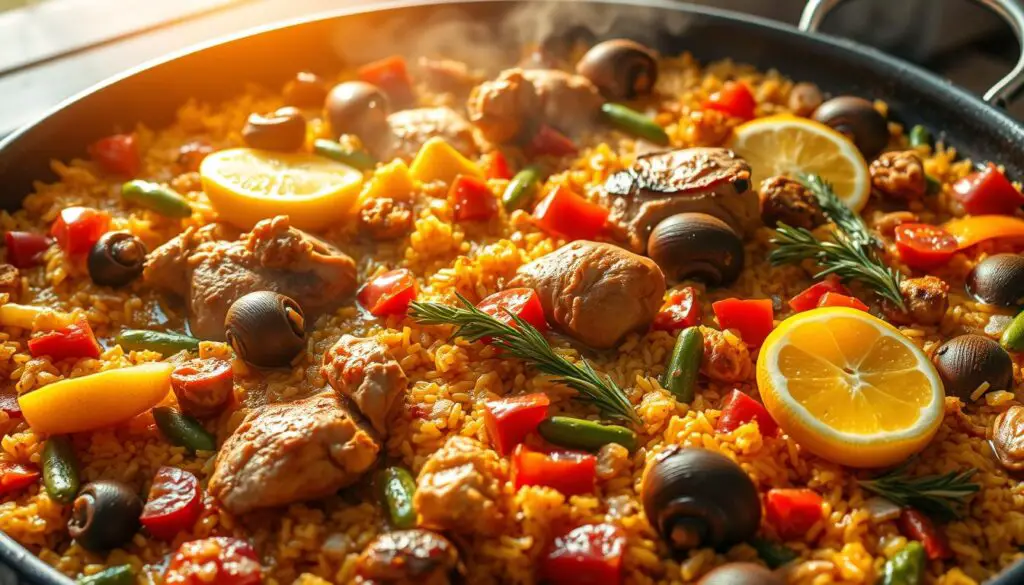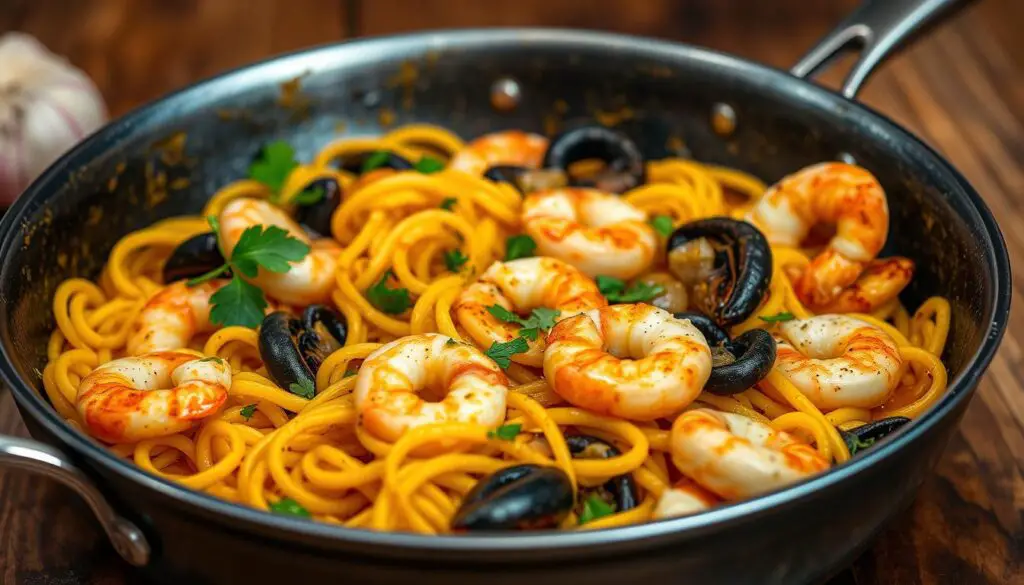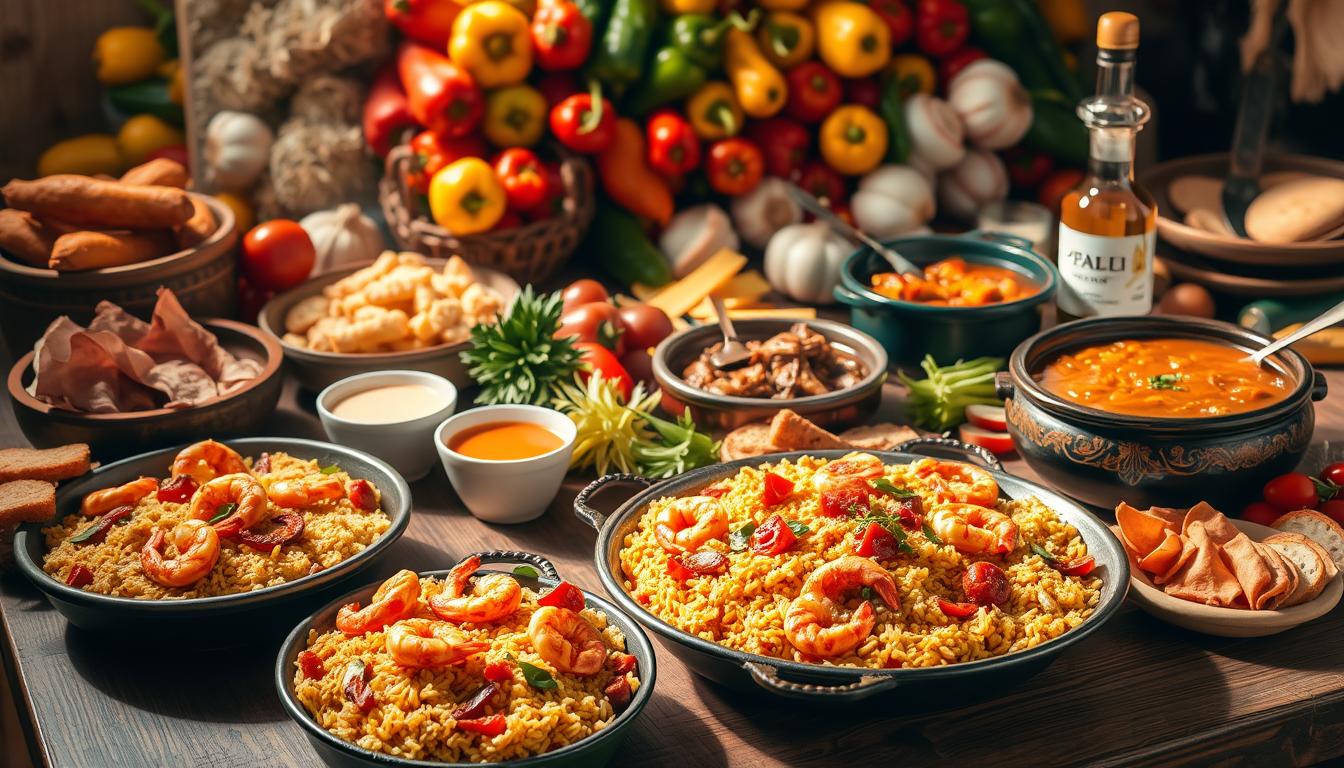If you love food or just want to try something new, this journey is for you. We’ll find the best Spanish dishes that show off Spain’s spirit. We’ll celebrate its tastes and traditions together.
This post may contain affiliate links where I get a commission on qualifying purchases at no extra cost to you.
Key Takeaways
- Spanish cuisine reflects the rich culture and history of Spain.
- Regional ingredients enhance the authenticity of iconic dishes.
- Iconic Spanish dishes offer a diverse range of flavors and textures.
- Traditional Spanish food is about more than just taste; it’s a cultural experience.
- Exploring Spanish food can be a delightful journey for all palates.
Introduction to Spanish Cuisine
Spanish food is full of flavor and tradition. It’s shaped by the country’s different places and weather. Coastal areas love seafood, while the land is home to meaty dishes.
Spanish food has been influenced by many cultures over time. You can see this in the use of fresh ingredients and local herbs. These add depth to dishes like paella and Andalusian recipes.
In Spain, food is about sharing and fun. Meals are times to be together, not just eat. Tapas, small dishes, let everyone try different tastes. This makes eating out a special event for everyone.
Traditional Spanish Food That Defines Spain
Traditional Spanish food shows Spain’s rich culture and varied regions. Key ingredients like olive oil, saffron, and garlic are vital. They help make Spain’s dishes so special.
Meals in Spain are all about sharing. Tapas, small dishes, bring people together. They make dining a special event. Tapas show off local tastes and cooking skills.
Different regions in Spain have their own food stories. From hearty stews to fresh seafood, there’s a lot to try. Each dish tells a story of Spain’s history and culture.
10 Spanish Dishes You Really Must Try
Spanish food is full of flavors and traditions. It shows the country’s rich culture and history. Each dish has its own special taste and story. Here are some must-try Spanish dishes that show Spain’s amazing food.
- Paella Valenciana – A festive rice dish with seafood, meats, and saffron, loved in Valencia.
- Tortilla Española – A tasty potato omelet, great for any time of day.
- Fideuà – A noodle dish with seafood, a twist on paella.
- Jamón Ibérico – Known for its taste, this cured ham is top-notch.
- Gazpacho – A cool soup from fresh veggies, perfect for summer.
- Patatas Bravas – Fried potatoes with spicy sauce, a tapas favorite.
- Pimientos de Padrón – Small green peppers, some spicy, some mild.
- Churros con Chocolate – Fried dough with thick hot chocolate, great for any time.
- Albóndigas – Meatballs in a tasty sauce, full of home-cooked love.
- Empanadas – Savoury pastries with meats or veggies, showing Spain’s food variety.
Trying these best Spanish dishes will show you Spain’s rich food history. Each dish has its own story, connecting you to Spain’s heart.
Paella Valenciana – The Quintessential Spanish Dish
Paella is a dish that shows the heart of Spanish food. It comes from Valencia. The dish is known for its bright colors and deep tastes.
It started in the areas around the Albufera lagoon. This is where rice grew well. Now, paella is a symbol of Spain’s food variety.
Origin and History of Paella
Paella’s story began in the mid-1800s. It’s a recent part of Spanish food. It was made for farmers and workers, cooked outside.
It used local foods like rabbit, chicken, and veggies. Today, it has old and new ways of making it, keeping its Valencia spirit.
Key Ingredients and Variations
For great paella, you need Bomba rice, saffron, and fresh veggies. Bomba rice keeps its shape and soaks up flavours well. Saffron makes it yellow and tasty.
There are many types, like seafood and veggie ones. Each place has its own special way of making it, staying true to its roots.
How to Enjoy Paella in Spain
In Spain, trying real paella is a must. Valencia has the best places to eat. Eating it where it was born is special.
Many places like to share it. This lets people enjoy it together. It’s a way to share Valencia’s food love.

Tortilla Española – A Spanish Classic
The Tortilla Española is a beloved dish in Spain. It’s made with eggs, potatoes, and onions. This mix makes a meal that’s both tasty and comforting.
This Spanish omelet is loved at any time. It’s eaten in homes and bars across Spain. You can have it warm or cold, as a main dish or with tapas.
It’s a dish full of tradition. Families share their special recipes for generations. It brings back memories of good times together.
Here’s a table showing how different regions make their Tortilla Española:
| Region | Main Variation | Description |
|---|---|---|
| Madrid | Traditional | Classic recipe with the essential ingredients of eggs, potatoes, and onions. |
| Valencia | Vegetable Tortilla | Includes seasonal vegetables like peppers and zucchini for an added flavour. |
| Andalusia | Chorizo Tortilla | Adds slices of spicy chorizo for a robust taste. |
Fideuà – A Unique Twist on Seafood Paella
Fideuà is a tasty twist on seafood paella, showing off Catalan cuisine’s rich flavors. It comes from the Mediterranean coast of Catalonia. This noodle dish is loved by locals and visitors for its seafood.
What Makes Fideuà Special
Fideuà is special because of its unique texture. It uses thin noodles, not rice like paella. This makes it both comforting and tasty.
Its mix of fresh ingredients brings the sea’s essence to your plate. It’s a must-try for those exploring Catalan cuisine.
Common Ingredients in Fideuà
The ingredients in fideuà reflect its coastal roots. You’ll find:
- Seafood like prawns, mussels, and squid
- Fish, often monkfish or cod
- Saffron for a golden hue and flavour
- Garlic and onions for a deep aroma
- Tomatoes for a fresh, tangy base
In local places, fideuà comes with alioli, a garlic mayonnaise. This mix of flavours shows off Catalonia’s culinary heritage.

Jamón – The Pride of Spanish Charcuterie
Jamón is very special in Spanish food. It shows what Spanish charcuterie is all about. Jamón Ibérico is the best, with its rich taste and smell.
The pigs that make Jamón Ibérico eat acorns in the oak forests. This makes their meat taste amazing. The curing process can take a long time, up to several years.
Jamón is a big part of Spanish meals, enjoyed at special times. It’s not just food, but a sign of good times together. Every slice is a piece of Spanish tradition and love.
Gazpacho – Refreshing Taste of Spain
Gazpacho is a cool soup from Spain, loved in the hot summer. It’s full of colors and fresh stuff, mainly from Andalusia. Tomatoes, peppers, cucumbers, and bread mix together for a tasty drink.
Variations of Gazpacho Across Regions
Gazpacho has many versions in Spain. Each place adds its own twist with local foods. Here are a few:
- Salmorejo: From Córdoba, it’s thicker with more bread and olive oil.
- Gazpacho Manchego: La Mancha’s version has meat, different from the usual veggies.
- Gazpacho Verde: This green one uses cucumbers and green peppers for a cool drink.
Gazpacho shows how flexible it is in Andalusian food. Every region makes it their own, blending old and new. It’s a must-try for anyone wanting to taste Spanish food.
Patatas Bravas – The Perfect Tapas Dish
Patatas Bravas is a top pick for Spanish tapas. It’s crispy fried potatoes with a tangy tomato sauce or creamy aioli. This mix of textures and tastes is loved everywhere.
This dish started in the mid-20th century in Spain. It’s a big part of Spanish snacks, enjoyed by friends in bars and restaurants. Each place has its own twist on the sauce, making it special.
Patatas Bravas is a key part of Spanish food. It brings people together, making meals fun and friendly. It’s a must-try for anyone exploring Spanish cuisine.
Pimientos de Padrón – A Spicy Surprising Snack
Pimientos de Padrón are small green peppers from Galicia, Spain. They add a fun twist to Spanish snacks. Sometimes, they can be spicy, which is exciting.
Making Pimientos de Padrón is easy and fun. They are sautéed in olive oil and seasoned with sea salt. This makes them a hit for tapas in Spain.
People love trying these peppers. It’s not just about the taste. It’s also about sharing them with others. This makes every meal special.
| Aspect | Description |
|---|---|
| Origin | Galicia, Spain |
| Flavour Profile | Mild with occasional spicy surprises |
| Preparation Method | Sautéed in olive oil, sprinkled with sea salt |
| Popular As | Unique tapas |
| Serving Suggestions | Served hot, often with a drink |
Pimientos de Padrón show how simple Spanish food can be. They also highlight the joy of sharing food with others. They are a must-try for anyone exploring Spanish food.
Conclusion
Our journey through Spanish cuisine shows us a world of colors and tastes. Each dish tells a story of Spain’s history and different regions. From paella to gazpacho, it’s a fun journey for everyone.
Trying these dishes is more than just eating. It connects us to Spain’s heart and soul. As you try new foods, you’ll see how food brings people together. It celebrates our cultures.
So, whether you’re in a tapas bar or making food at home, let Spanish cuisine excite you. It’s a journey that makes memories and connects us all.
FAQ
What are some iconic Spanish dishes I should try?
What is the difference between paella and fideuà?
Is gazpacho served warm?
How is Jamón Ibérico different from regular ham?
What are Patatas Bravas?
Are there vegetarian options in traditional Spanish cuisine?
What is the best way to enjoy authentic Spanish food in Spain?
Are there any spicy dishes in Spanish cuisine?
What makes Spanish cuisine unique?
Latest posts
- Fontwell Park: A Thrilling Day at the Races

- Explore Arundel’s Medieval Castle and Cathedral is it worth a visit?

- Greenwich Town Welcomes Rupert & Teddy, Restaurant, Bar & Deli

- Chichester Wetherspoons: Breakfast or Brunch – A Tough Choice


